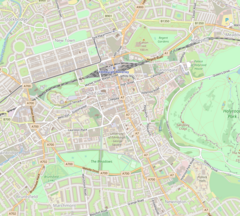Old Calton Cemetery
 |
|
| Location within central Edinburgh | |
| Details | |
|---|---|
| Established | 1718 |
| Location | Calton Hill, Edinburgh |
| Country | Scotland |
| Coordinates | 55°57′13″N 3°11′09″W / 55.9536°N 3.1859°W |
| Type | Public |
| Owned by | City of Edinburgh Council |
The Old Calton Burial Ground is a graveyard at Calton Hill, in Edinburgh, Scotland, to the north-east of the city centre. The burial ground was opened in 1718, and is the resting place of several notable Scots, including philosopher David Hume, scientist John Playfair, rival publishers William Blackwood and Archibald Constable, and clergyman Dr Robert Candlish. It is also the site of the Political Martyrs' Monument, an obelisk erected to the memory of a number of political reformers, and Scotland's American Civil War Memorial.
The burial ground was altered following the construction of Waterloo Place in 1819, which divided the graveyard into two sections. Along with Edinburgh's other historic graveyards, Old Calton is managed by City of Edinburgh Council. The burial ground, including screen walls, and its monuments are protected as a category A listed building.
The villagers of Calton, a village at the western base of Calton Hill, buried their dead at South Leith Parish Church. This was so inconvenient that, in 1718, the Society of the Incorporated Trades of Calton bought a half acre of ground at a cost of £1013 from Lord Balmerino, the feudal superior of the land, for use as a burial ground for the village. Permission was granted for an access road, originally known as High Calton and now the street called Calton Hill, up the steep hill from the village to the burial ground.
The Society of the Trades of Calton expanded the burial ground a number of times. Burials ceased in 1869 but the Society remained in control until 1888. A new road, named Waterloo Place after the contemporary victory at Waterloo, was approved in 1814 and built between 1815 and 1819. This road cut through the existing graveyard, requiring major removal of bodies and stones. Unusually for the period this was done with a high degree of decorum, bones being carefully grouped and wrapped for removal to New Calton Burial Ground, 0.5 kilometres (0.31 mi) eastwards, where several of the more substantial stones were also re-erected. These transported stones belie the age of that burial ground, as it is odd to find 18th-century stones in a 19th-century cemetery. Due to the cut, a small section of the graveyard is isolated to the north side of Waterloo Place, and is accessed from Calton Hill (the street). The building to its east, part of Archibald Elliot's Waterloo Place development, was originally the Calton Convening Rooms for the Incorporated Trades of Calton built as a replacement for their old convening rooms, which were demolished to make way for Waterloo Place and the Regent Bridge.
...
Wikipedia

